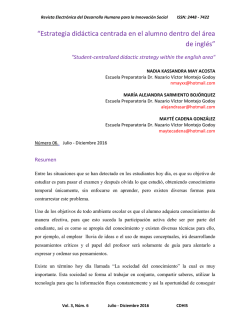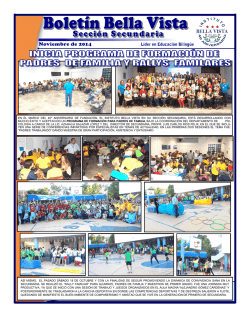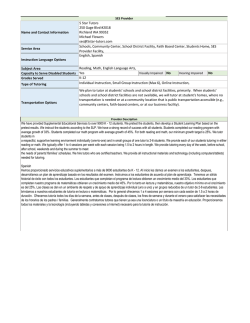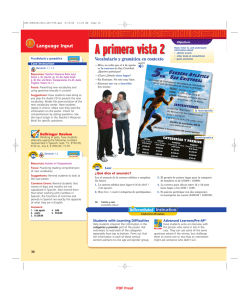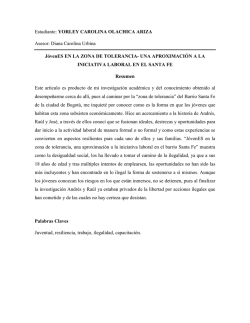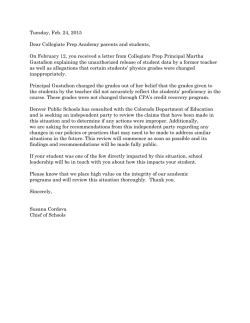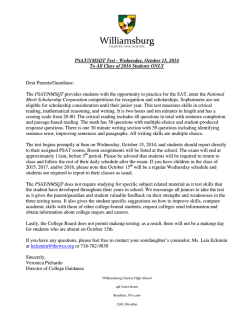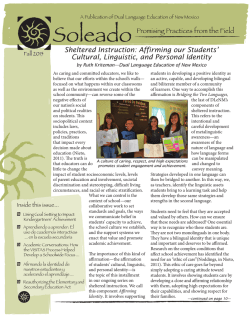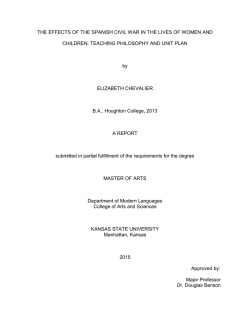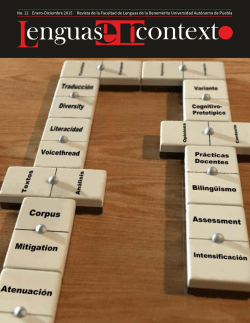
Review - tadamsspanishahs
RE3_08NLTE_Ch02_098-107.qxd 6/21/06 10:17 AM Review Review Activities Formas, géneros y materiales de arte/Profesiones artísticas: Have partners play Diez preguntas. One partner chooses a word or expression from these vocabulary categories. The other partner asks up to ten sí/no questions to try to determine what the word or expression is. Once the vocabulary item is determined or the asker is stumped, partners switch roles. Para describir una obra de arte: Ask students to go back through the works of art shown in this chapter of the Student Edition or on the Fine Arts Transparencies. Have them take turns asking and answering questions about the works of art: A: ¿Qué fue la fuente de inspiración para esta pintura? B: Pienso que fue la alegría de estar en casa. En el escenario/Sobre la actuación: Ask pairs of students to make a labeled sketch or computer-generated representation of a theater with actors on stage and an audience. Have them present these to other pairs, pointing out the various parts and people of the theater. For the Sobre la actuación category, they can make comments about the actors and the audience: Este señor se identifica con el galán. Otras palabras y expresiones: Students can use these words and expressions as they do the review activities for the other categories. Sobre la música y la danza: Have pairs of students take turns giving each other TPR commands: Toca la trompeta. Muéstrame unos pasos de tango. Canta … . Pretérito e imperfecto: You will need a small foam or paper cube. Write the numbers 1–4 on four of the sides. Sides 5–6 will not count. Sides 1–4 refer to the rules in the Pretérito e imperfecto chart. Divide the class into two teams. Rotate through each team so that only one student speaks for the team at a time. However, the team “speaker” can consult with teammates for up to thirty seconds before responding. 104 Page 104 R Vocabulario y gramática formas de arte la cerámica la escultura el mural la pintura géneros de arte el autorretrato la naturaleza muerta el retrato jed-0299 pottery sculpture mural painting self-portrait still life portrait materiales de arte la paleta palette el pincel brush profesiones artísticas writer el / la escritor(a) sculptor el / la escultor(a) poet el / la poeta para describir una obra de arte abstract abstracto, -a expresar(se) to express (oneself) famoso, -a famous la figura figure el fondo background la fuente de source of inspiración inspiration la imagen image influir (i ➞y) to influence inspirar to inspire la obra de arte work of art el primer plano foreground representar to represent el sentimiento feeling el siglo century el tema subject en el escenario el aplauso la entrada el escenario el espectáculo el micrófono 104 applause ticket stage show microphone otras palabras y expresiones through a través de to show mostrar(ue) to be standing parado, -a to stand up pararse to look, seem (like) parecerse (a) poem el poema realizar to perform, to accomplish la reseña review sentado, -a to be seated sonar (ue) (a) to sound like el taller workshop volverse (ue) to become sobre la música y la danza classical clásico, -a rhythm el compás band el conjunto dance la danza lyrics la letra melody la melodía movement el movimiento step el paso rhythm el ritmo drum el tambor trumpet la trompeta sobre la actuación actuar destacar(se) el entusiasmo exagerar el gesto identificarse con la interpretación interpretar to perform to stand out enthusiasm to exaggerate gesture to identify oneself with interpretation to interpret ciento cuatro Repaso del capítulo Students with Special Needs Advanced Students Provide concrete objects or listening examples to assist visually impaired students in their review of vocabulary from the chapter. Examples might include actual art pieces, art materials, as well as audio recordings of musical or dramatic performances. Have students use their creativity to make a video about a group of artists. Challenge them to incorporate all of the vocabulary on this page in their script. Remind them that there are many ways to do this. Some words might be seen on a sign in the background, others might occur in a letter someone reads, still others in a narration. RE3_08NLTE_Ch02_098-107.qxd 6/30/06 3:48 PM Page 105 Review pretérito e imperfecto Use the preterite to tell about an action that happened once and was completed. Use the imperfect to tell about habitual actions in the past. A menudo cantábamos juntos. Ayer escribí un poema. Use the imperfect to give background details, like time, date and weather. Eran las ocho y hacía mucho frío. Use the preterite and the imperfect together when an action interrupts another that is taking place in the past. Caminábamos por el parque cuando empezó a llover. estar + participio Estar + participio: Have students work in pairs. Each partner writes down five sentences about actions completed in the past tense: Carla abrió la ventana. They then take turns reading one sentence at a time to each other. The listener comes up with a sentence based on the one he or she hears, that uses estar + participio: La ventana está abierta. The past participle is frequently used with the verb estar. El teatro está cerrado. El tren está parado. In the following cases, the past participle is irregular. hacer: hecho cubrir: cubierto morir: muerto escribir: escrito abrir: abierto decir: dicho poner: puesto volver: vuelto descubrir: descubierto romper: roto ver: visto resolver: resuelto ser y estar Remember that ser and estar both mean to be in English, but have different meanings in Spanish. Use ser: to describe permanent characteristics La actriz es bonita. to tell the date Mañana es miércoles. to indicate possession Los pinceles son de Luis. Use estar: to describe temporary characteristics El escenario está oscuro. to indicate location Están sobre la mesa. to form the progressive tenses Estoy dibujando un retrato. Some adjectives have different meanings depending on whether they are used with ser or estar. Los niños están aburridos. (The children are bored.) verbos con significados diferentes en el pretérito y en el imperfecto The following Spanish verbs have different meanings in the imperfect and the preterite tenses. Yo conocía ese cuadro. (I knew about that painting.) Él conoció a su maestro en Perú. (He met his teacher in Perú.) No sabíamos que era tan tarde. (We didn’t know it was so late.) Nunca supe dónde estaba. noventa y uno 105 (I never found out where he/she was.) Capítulo 2 Sofía quiso ir, pero perdió el avión. (Sofía tried to go, but she missed the plane.) Antes no podía dibujar. (Before, I couldn’t draw.) Nunca pude dibujar. (I was never able to draw.) ciento cinco Capítulo 2 Ser y estar: Play a game that is set up the same way as the one for Pretérito e imperfecto. For rule number 4 in the chart, allow teams double the time (one minute) to come up with two sentences that contrast two different meanings of an adjective based on its use with ser and estar. Allow them to consult the Gramática on p. 88. Verbos con significados diferentes en el pretérito y en el imperfecto: Have students write their own exercises modeled after Actividad 36 on p. 90. Their exercises need not be in story form; a numbered list of five sentences is fine. Have them exchange quizzes, take each other’s quizzes, and check and discuss answers. Los niños son aburridos. (Children are boring.) Ellos querían viajar hoy. (They wanted to travel today.) (Cont’d): Team A rolls the cube and has thirty seconds to come up with a sentence that follows the rule that was rolled. If they do, they earn a point. If their sentence is incorrect or time runs out, play passes to Team B. The team with the best score out of 21 wins. 105 Enrich Your Teaching Resources for All Teachers Portfolio Invite students to review the activities they completed in this chapter, including written reports, visuals, tapes of oral presentations, or other projects. Have them select one or two items that they feel best demonstrate their achievements in Spanish. Include these products in students’ portfolios. Have them include this with the Chapter Checklist and Self-Assessment Worksheet. Additional Resources Student Resources: Realidades para hispanohablantes, pp. 72–73 Teacher-to-Teacher After students review the vocabulary on the previous page, organize a “vocabulary bee.” Have all students stand in a circle around the room. Give a student one item from the list. He or she has ten seconds to come up with a Spanish definition or explanation of the vocabulary or use it correctly in a sentence that clearly shows an understanding of its meaning. Students who make a mistake or run out of time sit down. The last student standing is the winner of the bee. CD-ROM Web Code: jed-0211 Teacher Resources: • Teacher’s Resource Book: Situation Cards, p. 83, Clip Art, pp. 84–90 • Assessment Program: Chapter Checklist and SelfAssessment Worksheet, pp. T49–T50 105 RE3_08NLTE_Ch02_098-107.qxd 6/21/06 10:17 AM Page 106 Chapter Review Review To prepare for the test, check to see if you . . . • know the new vocabulary and grammar Preparación para el examen Performance Tasks Standards: 1.1, 1.2, 1.3, 3.1 ANSWERS Student Resource: Realidades para 1 Vocabulario Escribe la letra de la palabra o expresión que mejor complete cada frase. Escribe tus respuestas en una hoja aparte. 1. El surrealismo fue de inspiración de los pintores Miró y Dalí. a. el espectáculo c. la melodía b. la fuente d. la reseña hispanohablantes, pp. 74–75 Teacher Resources: Teacher’s Resource Book: Audio Script, p. 73; Audio Program: Track 25; Answers on Transparencies 2. El actor principal entusiasmo. a. se interpretó b. se volvió 1. Vocabulario Suggestions: Encourage students to review the vocabulary from the A primera vista sections on pp. 68–71 and 82–85 before they complete the activity. b c c d 5. 6. 7. 8. b c c a 2. Gramática Suggestions: Remind students of the main points of the grammar presentations in Capítulo 2: • uses of the preterite and the imperfect tenses • constructions with estar + past participle • uses of ser vs. estar • adjectives that have different meanings when used in conjunction with the imperfect or the preterite tense 4. La familia es cuadros de Botero. a. el estilo b. el fondo d a d a 5. 6. 7. 8. principal de muchos c. la forma d. el tema 1. La semana pasada cerámica. a. me inscribo b. me inscribía en una clase de c. me inscribe d. me inscribí 2. No te van a oír bien porque el micrófono está . a. roto c. rompiendo b. rotas d. romper a a d c 3. El museo estaba a. abrí b. abriendo 4. Marta siempre un ensayo. a. está b. están 106 106 c. se destacó d. se inspiró 5. Picasso fue un pintor del XX. a. estilo c. año b. siglo d. ritmo 6. Cuando termina una obra se oye a. un paso c. un aplauso b. el micrófono d. la paleta . 7. La paleta de ese pintor colores vivos como el rojo y el anaranjado. a. actúa c. muestra b. interpreta d. realiza 8. Los actores no dijeron nada pero se expresaron muy bien con exagerados. a. gestos c. escenarios b. poemas d. compases 2 Gramática Escribe la letra de la palabra o expresión que mejor complete cada frase. Escribe tus respuestas en una hoja aparte. Answers: 1. 2. 3. 4. por su actuación y 3. Si quieres bailar salsa, necesitas aprender . a. la letra c. los pasos b. los gestos d. la actuación Answers: 1. 2. 3. 4. • can perform the tasks on pp. 106 and 107 todos los sábados. c. abiertos d. abierto nerviosa antes de c. es d. era 5. Ayer, a causa de los truenos, yo no dormir en toda la noche. a. pude c. puedo b. podía d. pudo 6. ¿Dónde a. conociste b. conoces a tu mejor amigo? c. conocías d. conocieron 7. Nos perdimos porque no bien la ciudad. a. conocemos c. conocías b. conocimos d. conocíamos 8. Yo esta mañana que la función tuvo mucho éxito. a. sabía c. supe b. sabe d. saben ciento seis Preparación para el examen Heritage Language Learners Students with Learning Difficulties Have students create a brochure for their own “virtual museum.” Encourage them to select artists and works from the chapter, from their own areas of interest, or from their heritage country. Remind students to tailor the language of their descriptions to the appropriate audience. In reviewing the vocabulary and grammar of the chapter, use gestures and facial expressions to support students in their choice of the correct answer. Use TPR to support meaning of the vocabulary choices. RE3_08NLTE_Ch02_098-107.qxd 6/21/06 10:18 AM Page 107 Review Más práctica ● Practice Workbook: Organizer, pp. 33–34 3. Escuchar Suggestions: Use the Audio CD or read from the script. For: Test Preparation Web Code: jed-0211 En el examen vas a . . . Éstas son las tareas de práctica que te Si necesitas repasar . . . pueden ser útiles para el examen . . . 3 Escuchar Escuchar y comprender la descripción de un cuadro El guía de un museo está describiendo uno de los cuadros de la galería de arte moderno. (a) ¿Qué tipo de pintura describe? (b) ¿Quién es el pintor? (c) ¿Qué se ve en primer plano? (d) ¿Qué se ve al fondo? (e) ¿Cómo son los colores? jed-0299 4 Hablar Hablar de las actividades que tienen lugar en una escuela de arte 5 Leer Leer y comprender las notas de un disco compacto pp. 68–69 A primera vista 1 p. 73 Actividades 8–9 p. 74 Actividad 11 p. 75 Actividades 12, 13 un paisaje Pablo Picasso una casa y árboles el mar Mediterráneo los colores no son vivos 4. Hablar Suggestions: Point out that this activity involves pair work. One partner should act as the new student, asking questions and making comments. The other should act as the student showing him or her around. The result is a dialogue. Un nuevo estudiante visita por primera vez p. 68 A primera vista 1 tu escuela de arte. Tu tarea es mostrarle los p. 72 Actividad 7 talleres de la escuela y explicarle lo que pasa en cada clase. Incluye en tu descripción (a) las clases que ofrecen, (b) los materiales que necesitan para cada clase, (c) las actividades que hacen en cada clase, (d) las obras que los estudiantes realizan en cada clase. Lee la reseña sobre un disco compacto y di (a) ¿cuál es el tipo de música del disco compacto?, (b) ¿qué cosas le gustaron al crítico?, (c) ¿qué no le gustó?, (d) ¿qué cree que puede ser mejor? Answers: a. b. c. d. e. Answers will vary. pp. 82–85 A primera vista 2 p. 86 Actividad 29 p. 87 Actividad 31 pp. 92–93 Actividades 38–39 5. Leer Suggestions: Tell students to refer to pp. 68–71 and 82–85 if they have questions about vocabulary in the music review. Answers: (a) salsa (b) el ritmo del tambor y la melodía de la primera canción (c) la trompeta en algunas canciones (d) la interpretación La letra de las canciones del conjunto Sol y salsa suena a poesía. Pero creo que la interpretación puede ser mejor. El ritmo que da el tambor se destaca del de la trompeta y va bien con todo el conjunto. Me gustó mucho la melodía de la primera canción. Cuando tocan la trompeta en algunas canciones, creo que exageran. Se ve que el conjunto se inspiró mucho al tocar la música. 6 Escribir Escribir una reseña sobre una obra de teatro que presentaron en tu escuela Trabajas como reportero(a) para el periódico de la escuela y tienes que escribir una reseña sobre una obra de teatro. Incluye (a) el nombre de la obra, (b) los actores principales, (c) una breve descripción del argumento, (d) la actuación de los protagonistas. pp. 84–85 A primera vista 2 p. 89 Actividad 34 pp. 92–93 Actividades 38–39 7 Pensar Demostrar cómo las artes pueden expresar las perspectivas y actitudes del artista Piensa en las obras de Goya, Dalí o Botero. ¿Como usaron su arte para expresar sus actitudes y sus perspectivas sobre lo que pasaba en sus vidas? ¿De qué manera expresan los jóvenes de hoy sus actitudes por el arte? pp. 86–87 Actividades 29–31 p. 89 Actividad 35 pp. 94–95 Puente a la cultura 6. Escribir Suggestions: Encourage students to organize their thoughts in a list like the one on p. 93 before writing their reviews. Answers will vary. 7. Pensar Suggestions: Encourage students to put their thoughts down using a a T-chart. They can label the columns Goya, Dalí, Botero and artistas jóvenes. Answers will vary. Assessment ciento siete Capítulo 2 107 • Assessment Program: Examen del capítulo • Test Bank: Tests A and B • • STUDENTS NEEDING EXTRA HELP • Alternate Assessment Program: Examen del capítulo 2 • Audio Program CD 12: Chap. 2, Track 3 Quiz on PresEXPRESS Audio Program CD 12: Chap. 2, Track 3 ADVANCED/PRE-AP* • Pre-AP* Test Bank • Pre-AP* Resource Book, pp. 137–139 HERITAGE LEARNERS • Assessment Program: Realidades para hispanohablantes: Examen del capítulo 2 • Heritage Learner Test Bank 107
© Copyright 2024
